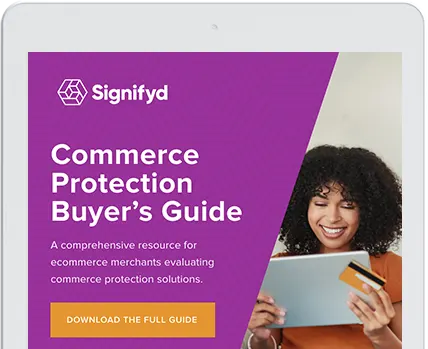Surrounded by the bustling ambiance of FLOW Summit 2022, Chris Deck of Deck Commerce gathered an eye-opening panel on “Removing Friction from the Customer Journey” with retail gurus David Cost of Rainbow Shops, Nathan Liu of Hot Topic and Sridhar Sundararajan of Newell Brands.
Reviewed, revised and approved by Signifyd humans.
Cost tackled the Shopify universe, explaining Rainbow Shops’ strategy: It’s not about which apps to use, but how they’re integrated. Highlighting the tricky terrain of performance impact, he drove home the need for brands to keep their online storefronts agile and clutter-free.
Speakers
 David Cost
David Cost
VP of Digital & Ecommerce, Rainbow shops
 Nathan Liu
Nathan Liu
SVP, Ecommerce & Customer Engagement, Hot Topic
 Sridhar Sundararajan
Sridhar Sundararajan
Director, Digital Technology, Newell Brands
 Chris Deck
Chris Deck
Founder/CEO at Deck Commerce
Payment methods? Another minefield. Cost shared insights on integrating Rainbow’s checkout software with Klarna, pointing out that while such platforms might be shiny and new, and popular among existing customers, they aren’t necessarily magnets for new customers. He said he saw a similar trend back when PayPal was a new option.
Nathan Liu waded into the challenges of balancing digital conveniences with real-world immediacies. Think buy online, pick up in store – sounds simple, right? Not when burdensome fraud checks create unintentional bottlenecks.
Sridhar’s take? Ecommerce is a relentless game of adapt or perish. Consumer behavior isn’t static; it’s an ever-shifting terrain, and brands need to be nimble-footed.
In the whirlwind world of ecommerce, the goal is clear – keep it seamless; keep it customer-centric. Brands need agility, adaptability and a touch of foresight to truly ace the game.
TRANSCRIPT OF SESSION
Simplify order management
Thank you all for being here again. So, I get to introduce Chris Deck, who is the CEO of Deck Commerce… So, he is… I’ve got all kinds of fun stuff here… a lot of fun facts… He’s the founder and CEO of Deck Commerce, who’s the market’s leading order management system for direct-to-consumer commerce. Prior to that, he’s led ecommerce consulting agency and the career of the banking industry, which makes sense… Chris lives in St. Louis… that’s the one with the arch, right? Yeah, okay, good… And he’s an adoring husband, although I’ve talked to his wife; she may disagree, and a wonderful father. And he loves to be golfing and… this is my favorite… sipping whiskey, which is what we’re doing tonight at the Flatiron. We’re doing whiskey tasting, so you’re in luck. Big round of applause, Chris Deck!
Thank you. I think you stole all my thunder on the introduction. I guess the only thing that I’ll say about Deck Commerce and order management is our tagline is to simplify order management. It can be a very complex and daunting technology challenge. And because we’ve got an API-first architecture, and we focus really on the customer, the consumer shopping journey with everything we do, we bring simplicity and flexibility to what is otherwise a really complicated set of business needs. So, why don’t you guys come out, and we’ll do some introductions… [Applause] [Music]
Introductions
Nathan, we’ll start with you and then we’ll head on right on down the list. Okay, so, Nathan Liu… I work for a company called Hot Topic. You probably remember us from when you were young, going to the mall. We’re a bit different today. We actually are… We have several brands under our portfolio: Hot Topic, BoxLunch, Channel, a direct consumer business, Her Universe… And this… I’ve been with the company for four years, but it’s great to see how much the company has evolved from a traditional mall retailer into really a massive multi-channel company with multiple brands. Let’s see… I’ve been there four years, oversee our e-commerce business and digital marketing. David?
I’m David Cost. I’m responsible for digital and e-commerce at Rainbow Shops. Rainbow, if you don’t know… I couldn’t describe Rainbow as… it’s a kind of a TJ Maxx format with Forever 21 kind of clothes. So, we sell clothing for women in both juniors and plus sizes as well as kids. We operate about 1,100 brick-and-mortar stores in the U.S. as well as the online presence.
Sridhar, good afternoon. I’m Sridhar Sundararajan. I work for Newell Brands. We have some of the popular consumer brands like Yankee Candle, Coleman, Crockpot, Sharpie, Expo… I’m part of the digital technology team, and I’m responsible for enterprise systems there. And last three years, we have been on a journey of transforming and what we do for all our direct to consumer websites, catalog websites, and marketing websites.
Removing friction
Great, so we’re going to talk today about how to remove friction from the consumer buying journey. And I’ve had the chance to talk to these guys over the last couple weeks, and they have some really amazing stories. So, we’ll ask each of them to kind of highlight some of the key learnings from what they’ve done, and then hopefully, if there’s time, we’ll take some questions and answers from you guys.
So, David, I’m going to start with you. You know, I was fascinated… you did a re-platforming site, and it was a big goal, a big push for your company. And I was… I just was blown away by some of the expedited checkout work that you did and how that kind of helped remove friction from the buying process. Could you share the lessons learned and all that?
Replatforming to Shopify
Yep, so we were on Demandware Commerce Cloud for about 10 years and made a decision to re-platform to Shopify. We went live on Shopify at the end of July last year. One of the main drivers in doing that was because of the checkout. Right, we really felt that Shopify’s checkout was really almost as good as Amazon’s, and Amazon kind of sets the standard. You know, coming from the world in Salesforce where checkout is infinitely adjustable or infinitely customizable to a world where checkout is pretty rigid… rigid is better. You know, we’ve seen in general a 10 to 15 percent conversion rate increase that we really feel is because checkout is so much more stable on Shopify than it was on Salesforce. As well as the expedited payment mechanisms, or the reduced friction payment mechanisms. So, ShopPay is… was a big reason for why… one of the reasons why we moved. This is where if you’ve shopped on any of the two million merchants that are on Shopify, they identify you when you go to any other Shopify merchant, and a customer literally gets texted a six-digit code that they can type in, and checkout’s done. You know, that’s over 20% of our checkouts from almost from the day we turned it on. The ability to drop other kind of payment mechanisms in… so we recently launched Klarna and have been kind of again blown away by the customer’s uptake on that platform. So, Klarna now is about 17% of our checkouts. So, we add up ShopPay and Klarna, people who log in… now the majority of our checkouts are expedited, are not guest checkouts, and it makes a difference in conversion rate.
I mean, would you say 10 to 15 percent?… That is an amazing jump when you think of a conversion rate… So that’s really impressive.
Streamlining false declines
Cool, Nathan… You guys were sensing some friction as it related to the fraud. How did you guys identify that friction, and what did you do to streamline it?
Yeah, so… One thing that’s really cool about our company is, whenever someone new starts with the company, they spend half a day in our call center shadowing call center agents and listening to calls… When I started four years ago, I actually ended up spending quite a bit of time in our call center the first two weeks I was there… I just felt like it was an area that I could learn a lot about the customer and the customer experience very quickly… So, one of the key things that came out of those conversations was how many contacts we were getting on fraud declines… Customers who call us that place an order… I don’t know why it’s canceled, and then we look back… It was a fraud. It was a fraud canceled… And what’s really difficult is, for the agents… it’s very difficult for them to resolve those tickets because there’s nothing they can do for the customer. We already declined them. Things they bought probably sold out, and we’re only able to replace… And what we saw was, we lost that customer… And when you think about it… I really talk about acquisition costs going up… We’re spending a good chunk of money getting these customers, doing everything we can to provide a good experience, but then we lose them after they complete the transactions… Kind of like what Cal said this morning… We lost that shopping cart… We’re like, we just didn’t have the shopping cart for the customer… So, through that, we began to dive into the data and really understood, talking with the fraud team, why they were declining these orders… Their feedback was they were quite constrained by the tool that they had… And our sense was that there was a very high level of false positives, but we didn’t have the right tools to figure out how to recapture them… I can keep going…
Tools
Yeah, so… I’d love to know the tools that you were using, and then how did you solve the problem? That would be great…
Yeah, so… We knew that we had to go recapture these orders… We began to test some different things, and then what we were really nervous about was chargeback rates going up… Like this time, finance hits me up and says, “Hey, Visa’s been calling us,” and I started to get sweaty because our chargeback rates are too high… So our hands were relatively tied… We began to look at vendors that specialized in this… I talked to a handful of different vendors… We ended up having a really great conversation with Signifyd… Surprise! Having a great conversation with Signifyd… And they were able to come to the table with a structure that we felt could really work well for us with a guaranteed payback, risk guarantee… And on top of which, I think all the conversations that we were having was about how do we maximize the amount of approval rates… Which, versus our opener, there… It was the question of… It was so… It’s funny, we actually review when we had our QBR’s with our opener… The metric was how much fraud did we help you prevent… And really, that was just the total number of declines that we had minus chargebacks… So the incentive was never there to maximize customer experience and approval rates… So when we talked to Signifyd, they had this structure where it was really about how do we help you approve more and more orders… And we were skeptical because my team said, “Hey, we’re doing the best we can. We have all the customer info. I think we’re already at max.” But when we… So we challenged Signifyd… How do you show us an ROI that we can be comfortable with before doing integration?… And through that challenge, we were able to feed them a whole list of orders that we were declining… And then they came back and said, “We can guarantee up to 75 percent of these orders.”… And this gave us more confidence to start a partnership with them…
Three valuable improvements
Wow, so… It sounds like there’s at least three areas of value there… Number one, you are now accepting orders that are probably good… Certain you’re giving better consumer shopping experiences… Number two, you’re doing a lot of manual work on calls and customer service activities that have been pretty much wiped clean… And then, I’m assuming, with the way the Signifyd model works from a loss perspective, you’ve probably seen great improvements there as well… Is that a pretty fair way to describe the wins?
Yeah, I think so… So we get very few customer contacts now regarding fraud… Results-wise, over the last couple of years, we recovered about five million dollars worth of revenue… But I think, more than that, it’s that five million revenue was a hundred thousand customers… And sometimes I had to get my head wrapped around that and say, “Hey, this… There’s enough people to fill them into a Staples Center… Yeah, sorry, Crypto.com, isn’t it?”… And that’s a lot of people that we upset in the past… And now that we are able to recapture them and turn them into loyal customers, advocates… So that’s really what we talked about as a win.
Smoothing out back-end friction
So, I know… It was really an area that nobody was paying attention to but is a huge negative experience for that group of people… Yeah, it’s amazing… Street art… My friend, full disclosure, Srigar is a customer of ours and we’ve been on an odyssey… We call it… It’s the code name for a project we’ve been working for three years helping Newell Brands who, as Sridhar mentioned, has a whole variety of brands underneath them that are very well known and very proud to show the company… And as a result, they also have almost that many ERP systems running their back-end business systems… So I believe that before we started this project, ERP and back-end processing was a major friction point for Newell Brands… Tell us what that looked like on the before scene and then we can talk about how it’s looking like now in the after…
Absolutely, Chris… If you look into most of the consumer goods company, we grow by acquisition… So Newell is no different… We also grew by acquisition… It also means that we inherited quite a number of technological architecture… So any platform you look, we have five or six different flavors… So it is not a sustainable model… So we had an opportunity to consolidate into one model… Some areas, by and large, we are doing well… Some areas we are not doing well… So we had an opportunity to really look into our dated technology stack and pick the right products and start migrating to that specific stack… So we definitely felt that the stack is missing some elements… There are quite a number of things… So we didn’t have a direct consumer-focused order management system… We didn’t have a strong fraud management… So we made sure that these components are built into the technology stack so that we can grow… And my responsibility was more of back-end removal of friction… So this is after the consumer goes and clicks the submit button in the cart… So the post-purchase journey friction… The best place to get insights on what we need to resolve is our consumer services team… So they get the call day in, day out… So we reached out to them and asked, “Hey, based on the call volumes, can you please tell us what are the areas our consumers want additional help?”… In the first place, they should not have called… It’s a cost to the company… So they identified at least three areas to focus for us… One, a lot of calls people get because they are not sure where their order is… So, order status… Then second one is about the payment way it is working… Specifically, there were some double authorization… And oftentimes, what we authorized, this is what we captured… There was a difference… Consumers don’t have an issue if we capture less but they really are considerable if you go more… So then the third area is the entire return and refund process… So these were the initial focus areas… I can talk about a little more on what we found on the way… So we thought, okay, let’s dissect each of them and address them… So with respect to consumers knowing where their order is, we put together an email journey for the customers… What are the trigger points when we can send communication to the consumer?… He or she really wanted to know about it… So we catch a very common one, right?… The order confirmation, order shipment, cancellation of its order or line item… So we made sure that all these touch points are identified and we have a flexibility in the system to turn on or off these communication… Because what you initially think is right might not be right… But so you should have the flexibility to toggle whenever needed… So that way now the number of questions come for order status has significantly come down for all our brands… Then the second one is with respect to payments.
So, we looked into the process and I was telling you… You initially alluded to those ERP systems… Right? So, when we were able to bring together various different technology sets, but we knew that we will still end up having three different ERPs that we need to run with… So, any processes we build should keep in mind all these three ERP leads… So, if you look into this payment of the returns, there’s a lot of ERP related elements that’s there… So, we identify areas… What is causing this double authorization? What is causing this capture versus authorization mismatches? So, we streamline the processes… As well as, we made sure that we use the same systems of reference while taking the orders as well as fulfilling orders… And a lot of things got resolved automatically…
Improving refunds
Then with respect to refunds, we wanted to make sure that we give a little more power to the end consumers… No one has time to call our consumer services… So, the more power you give to them, the lesser effort for your teams… We wanted to make sure we give a tool for them for tracking and an easy returns process… So, by giving that, not only we eliminated quite a number of calls, it’s not only ease for our consumers, but the way we tied what is being returned and the number of touch points you need to have in the warehouse, we brought down significantly… So, it is one, ease of return and second, is how quickly you’re able to process the refund… So, we were able to solve all these three and if we feel like we are progressing in the right way… Do you have any early read on some numbers like call center volume being down or better customer experience? Do you have anything that you can share on the progress? I don’t have a specific number to share but definitely, all these three areas we have improved significantly…
And as you evolve, there are always some surprise elements… Right? During the pandemic, pretty much all the companies who have stores, they all wanted to get into omni channel… Right? So, we had to stand up an omni channel in a very short period of time… So, one area we feel like now we are getting calls is with respect to some orders associated with the omni channel… But we are very confident that we would be able to stabilize and move forward with that…
Yeah, go ahead… Sorry… One, just with respect to metrics, like you are looking for, but I can share one metric for sure… While we have an issue with the omni channel, specifically the ship from store, what we have seen is whatever orders were taken on a day, 40 percent of the orders are fulfilled on the very same day and 75 orders are fulfilled within 24 hours… And where it really played a big role is before holiday season because the websites freeze the purchase commitment… Right? So, at this point of time, I can’t commit I can deliver by Christmas… Right? So, but with ship from store, we were able to throttle and make a few more guests happy… So, that’s the balance we got out of it…
Conference themes
I mean, when you think about the theme of this conference that we’ve had today so far, starting from the initial panel discussion, it’s all about the consumer… First of all, that just is a theme that drives through… Number two, it’s also about owning the shopping cart, getting that return on the shopping cart… Which, he better trademark that because it’s gonna be a new thing… And you know, we started with David talking about how they focused on the express checkout and the results they’re seeing from an increased conversion rate and a faster expedited checkout… And then I thought it was cool that Nathan brought us into, okay, we’ve got an order, how do you manage the fraud and remove the friction from the processing of that order in the first couple of touch points… And then, Sridar, you brought us home… The shopping experience goes all the way to returns… It goes to getting that product to the customer’s door with clarity, speed, and accuracy… And then being there for them when they’ve gotta make a return for whatever reason… So, I think that the friction has to be looked at from the beginning touch point, checkout, processing and whatnot… So, we’re open for questions if you guys have any… And I’ve got a couple more for the… Okay, we’ve got a question… So, good professor, on topic…
Long-term value
Did you see… I guess an uptick in long-term value?
Yeah… Oh for sure, Nathan. Let me… let me repeat the question just so that they get it on the video, on the recording. So the question was, with all these upchecking customers, the 100,000 customers that you were declining as fraud, are you seeing an uptick in long-term value, lifetime value of the customer? Yeah for sure. I think what we’re seeing is that they very much behave like our regular customers who purchase multiple times through a year, and we’re able to capture that… And in fact, what’s interesting, a lot of folks that we were declining were first-time shoppers with us which, because we didn’t have the right… we didn’t have the right data within our file to say that they were good. And one other thing, in many cases, they were actually higher value customers because the basket size was being used as a metric to decline. So when the basket size was too high, we’re saying, “Hey, this is too risky”… That was actually a metric we’re taking into consideration. So in many cases, we’re declining very high value customers. So it was… it’s been great to see that as we change this, lifetime value has followed within that cohort… Wow. I have a microphone by the way, so next question.
I scared everybody because I have a microphone… While you guys are thinking, what’s next for you, David? What’s next on the… on the roadmap for removing friction?
Friction roadmap
So we’re working on site speed right now… We’ve got a good score relative to our competitive set, but it’s not good enough… and so site speed’s an area that we’re putting a lot of focus on right now. What’s the… is there a benchmark… is there certain seconds per page that you’re shooting for?
We want a full green score from Google… Okay, that’s what we’re shooting for. Cool. And right now in our competitive space, not a single retailer has a green score… Wow. Right, it’s kind of amazing. Cool. Nathan, what about you? What… what’s on your roadmap? What… what’s the rest of 2022 going to look like?
Yeah, so I certainly agree with David on the speed aspect of it. What we’re seeing is, obviously the speed is not just impacting the customer experience, also impacting our SEO, impacting other aspects that, you know, you don’t normally see customers facing… so that’s a huge focus for us. The other focus, I think is, and other people have brought this up, acquisition cost has increased significantly, so we’re really looking at opportunities to like…
We have over 6 million people in our loyalty program and the idea is really, how do we activate them in a more meaningful… more meaningful way and create those… create those relationships where we can lean back on and drive them to not only be customers but really brand advocates for us… Great. Sridar, our focus is going to be more on stabilizing omnichannel. So we definitely wanted to bring down the cancel percentages that we are having. So we have multiple levers, you can use the safety, start optimizing the safety stock, improve the accuracy of the inventory at stores, then ability to quickly turn on or turn off the stores. So how nimble we can get with respect to all these omni channel elements to make sure that our guests have the best experience. So we all saw from morning quite a number of important points being shared about retaining the customer… Right. So that you can’t miss on a consumer and never give a… any bad taste to them in the experience… So we wanted to make sure that what they ended up with on our website to do, they were able to accomplish those objectives… so that can make our guest experience as better as possible… Awesome.
Okay, we gotta…
Order management systems
Okay, I guess there’s questions for Sridar… So I… I completely agree. I think it’s really important to think about… you know, the best acquisition is retention… and one key thing, I guess that would be curious to hear is, how are you guys tackling with all the different replatforms that you’ve been doing? How are you tackling like WISMOS, like where is my order? Right?
Yeah, so you know, you get that out of an order management system… You know, you get all the various statuses out of an order management system. But how are you guys tapping that to say, okay, I’m going to retain this customer… They’re returning the product, are they returning and abandoning and not coming back? Is it a bad experience or are you using that as a touch point to convert them again?
We do all of them… So, so with respect to ability, we… we have a Narwhal system in place for them to engage with us. And having this direct consumer focused order management system, this is helping us to focus a little more on various subcategories. Okay, if I have a overnight shipping, am I able to track through the entire cycle of that specific consumer? So for any reason, if I have to end up cancelling their order, so even before the consumer calls, we want to make sure we call our consumer and provide them the reasoning, provide some appeasement and try our best to hold on to them… But obviously we wanted to look into the next levels of how to retain these engagements… but our consumer services team is doing a fantastic job on proactively reaching out to the consumers by looking into these tools at this point of time.
Cool. Well, it’s a quiet group. What we needed… a fire alarm to ask each one? Just… Oh, here we go. And then also, let’s… We can wrap it up with some closing thoughts from each of you. Okay?
Building in Shopify
Yeah. Okay, sorry, I missed your name, but for Rainbow site… You’re going to Shopify. There’s so many apps and plugins that you could use, and I know you’re working on getting the fastest speed website. How do you sift through the apps and know what to include, like cross-sell, upsell, the questionnaires, without overloading the site to make it slower? Because you could add everything in there, but then you got a site that’s, you know, somewhat overloaded. Or do you not see that as an issue?
No, no. We’re very careful with what apps we add. Would you be able to go into categories you think are extremely important to have?
It’s not category, it’s… it’s how that app is implemented, right? So we’re checking ahead of time about what its impact on performance is going to be before adding it. And if it’s coded in the wrong way, we’ll reach out to the company and see if they’re willing to recode it differently to mitigate the problem. And if not, we won’t install that app. But you’re right, with Shopify, you have to be… It wasn’t that different in Salesforce. You got to be very careful what third parties you install and how that third party is going to impact your overall performance.
Customer acquisition
We got a question back here. Hi, this is for David. You talked a little bit about how you installed Shop Pay and Klarna, and how you now see a significant percentage of your customers transacting through that. Can you talk a little bit about whether those were already existing customers to file, and now they’re transacting through these other payment methods, or whether you somehow also saw acquisition through these new payment methods?
I mean, the honest answer is we don’t know. I don’t suspect that any of it was… Very little of it was new business. You know, it’s not dissimilar to… I’m trying to think, how many years ago when we put PayPal on the site for the first time? We went from zero to 20 percent in a day, so clearly there was pent-up demand in the user base for that payment mechanism. How Klarna gets to 15 to 17 percent by just flipping a switch, those aren’t new people coming. Those are people that are already there that now see that option, and that’s the option that they prefer.
Oh, one more question. Okay, I think this will be the last question. I’ll ask for closing remarks.
Testing methods for Shopify
Okay, thank you. A comment and a question: For anyone that happens to be using Shopify Plus, you can actually ask your success manager to tell you what the data is behind how many of your customers are using Shop Pay actively. So, if that’s helpful information for anyone using Shopify. But my question is, how do you decide… This is for anyone. How do you decide which apps, similar to your question, determine the length of time you’ll test them out before deciding whether or not they’re just a distraction to your customers, and create friction, and they end up getting distracted and dropping off, and potentially harming your conversion rate?
So, we’ve got base level performance scores before we put on the app, and then we look at it afterwards. If performance goes down in a way that we find unsatisfactory, then we kill it before it even gets started. Look, there’s some core functionality you’re going to want, need for your website. So, there will be a vendor out there that can do it in a performant manner. You just kind of have to be careful as you go through that process.
Alright, well, we’ll share some closing remarks. Sridhara, we’ll start off with you. From a friction perspective, anything else? Any advice you’d like to share with the rest of the team?
Closing remarks
Consumer behavior will continue to change, and… It’s the e-commerce journey. It’s more or less like a daily grind. So, having the right tools in place will enable you to change fast, as well as identify the changes sooner, so that you can adapt yourself. And keeping every guest coming to our website has to be our primary objective. And a lot of focus needs to be put into it and continue to monitor it.
Cool. David?
I mean, my piece of advice would be… Be careful what you see or follow in terms of idealized performance metrics. Look at people in your space and what they’re doing. Early on, we became kind of obsessed with a given performance number and modified the site pretty significantly to be able to get there and actually saw it be a huge negative. I could tell you, in the fashion space, customers are more interested in more images, and they don’t care that it takes more time for those images to download. So, you can have fashion websites that may have a 14-15 second load time. If you took it down to the magic two or three, customers would disappear. It depends on what you’re selling and what your customer mix is. That drives what performance metrics you need to pay attention to and follow.
Nathan?
I think, just as you’re introducing new functionalities and new ways for the customer to shop, it could be introducing other pressure points you’re not expecting. So, when we put into place… Think about the fire alarm, but BOPIS and putting in BOPUS and also curbside… There’s an immediacy to that, an expectation of “I’m gonna go pick up as soon as possible.” But some of those orders were being stuck in fraud, waiting for manual review. That slowed down the process. So that, even though we weren’t going to cancel those orders, just that delay caused extra friction. So we worked through that process with our vendor, Signifyd. But it’s something you should pay attention to. As things are put in place, what is the entire journey and then, what are the potential friction points? So you’re solving that ahead of time.
So, if I can summarize what I’ve just heard: Put your customer first, damn the KPIs if they’re not relevant to your specific business, and remove friction with speed. Do things quickly, learn quickly, adjust quickly, try to make sure that customers are communicated with quickly and clearly. And that should help. So, thanks everyone. Let’s give them a big round of applause.









